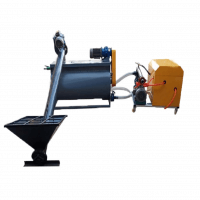Professional solutions on concrete addtives, Concrete Foaming Agent, Superplasticizer, CLC Blocks Additives, and foaming machine
(Why is polycarboxylate superplasticizer more suitable for modern concrete?)
Modern concrete is represented by ready-mixed concrete produced in industrialization, and pumping construction is the mainstream. Mechanical properties are no longer the only technical index of modern concrete, and the control of mixing and rheological properties is particularly important to ensure the construction. At the same time, the requirements to ensure the durability of concrete structures are increasing day by day. In the process of production and use, we should pursue the principle of sustainable development.
Technical characteristics of modern concrete
More complex components
The wide application of mineral admixtures mainly derived from industrial solid wastes diversifies the composition of cementitious materials, which is one of the main characteristics of modern concrete. Conventional mineral admixtures such as ground slag powder and fly ash have become important components of modern concrete, and functional mineral admixtures such as silica fume, ultra-fine stone powder, calcined kaolin and zeolite powder have also been applied in modern concrete. as mineral admixtures, various metallurgical and industrial tailings have been gradually applied to modern concrete. Chemical admixture represented by high-performance superplasticizer is another main feature of modern concrete. the emergence of high-performance superplasticizer greatly reduces the water-binder ratio of concrete, and the strength of concrete has been greatly improved. Ultra-high-strength concrete above C100 has achieved high-rise pumping construction. Some special materials are also gradually applied to modern concrete, such as expansive agent, fiber material, air entraining agent, consistency adjustment material, density adjustment material, durability reinforcement material and so on. In terms of concrete aggregate, high-quality natural aggregate resources are increasingly scarce, machine-made sand and low-grade aggregate have begun to enter the field of ready-mixed concrete, and the water absorption and mud content of aggregate are increasing. With the complexity and diversification of modern concrete components, the initial fluidity of concrete is greatly reduced and it is more difficult to maintain the fluidity of concrete.
Higher construction requirements
The complex structure and harsh construction environment of modern engineering require higher and higher fluidity of concrete. The construction of super high-rise, super-large volume and complex structure requires excellent pumping performance of concrete, and can realize self-compacting construction, so as to reduce labor intensity and ensure the compactness of concrete; long-distance transportation or long-time pouring requires a long time to keep concrete fluidity; nuclear power and hydropower projects require concrete fluidity to be stable and has little fluctuation over time. The super early strength project requires not only high early strength of concrete, but also long construction time; in harsh environment, especially in the high temperature environment above 40 ℃, the hydration rate of cement is intensified, but concrete is still required to be pumped for construction after 3 hours. Therefore, high fluidity and fluidity, good and workability, and can achieve self-compaction is the fundamental to meet the requirements of modern concrete construction.
The problem of shrinkage cracking is more prominent.
The large amount of modern concrete cementitious materials, finer and finer cement, more and more complex components and lower water-binder ratio make the problem of shrinkage cracking more prominent. The simple pursuit of high profit to meet the strength makes the effect of cement through grinding aids become finer and finer, the specific surface area is as high as 420m2/kg, the hydration rate is accelerated, the hydration heat release rate increases, and the internal water consumption rate of concrete is too fast, and the development of high strength reduces the water-binder ratio to 0.18 and free water. The extensive use of ultra-fine mineral admixtures increases the shrinkage of concrete, increases the sensitivity of cracking, and makes concrete more prone to shrinkage cracks, thus reducing the frost resistance, carbonation resistance, corrosion resistance and so on. In addition, with the continuous expansion of the scope of human activities and the progress of construction technology, concrete projects in harsh environments such as dryness, cold and heavy corrosion are increasing day by day, and modern concrete is facing a harsher service environment than traditional concrete. the risk of cracking increases, and the problem of durability is more prominent.
Why is polycarboxylate superplasticizer more suitable for modern concrete?
The traditional lignin sulfonates, naphthalenesulfonic acid condensates and aliphatic superplasticizers have limited dispersion ability and low water reducing rate because of their inherent molecular structure. even if the content is increased, it is difficult to meet the requirements of high fluidity and fluidity of modern concrete under the condition of complex components and low water-binder ratio. Polycarboxylate admixture has flexible molecular structure and strong designability. Through targeted molecular construction, high performance and functionalization can be achieved to meet the different performance requirements of modern concrete, so as to improve the engineering quality.
Concrete Additives Supplier
TRUNNANO is a reliable foaming agents supplier with over 12-year experience in nano-building energy conservation and nanotechnology development.
If you are looking for high-quality polycarboxylate superplasticizer, please feel free to contact us and send an inquiry. (sales@cabr-concrete.com)
We accept payment via Credit Card, T/T, West Union, and Paypal. TRUNNANO will ship the goods to customers overseas through FedEx, DHL, by air, or by sea.
(Why is polycarboxylate superplasticizer more suitable for modern concrete?)







